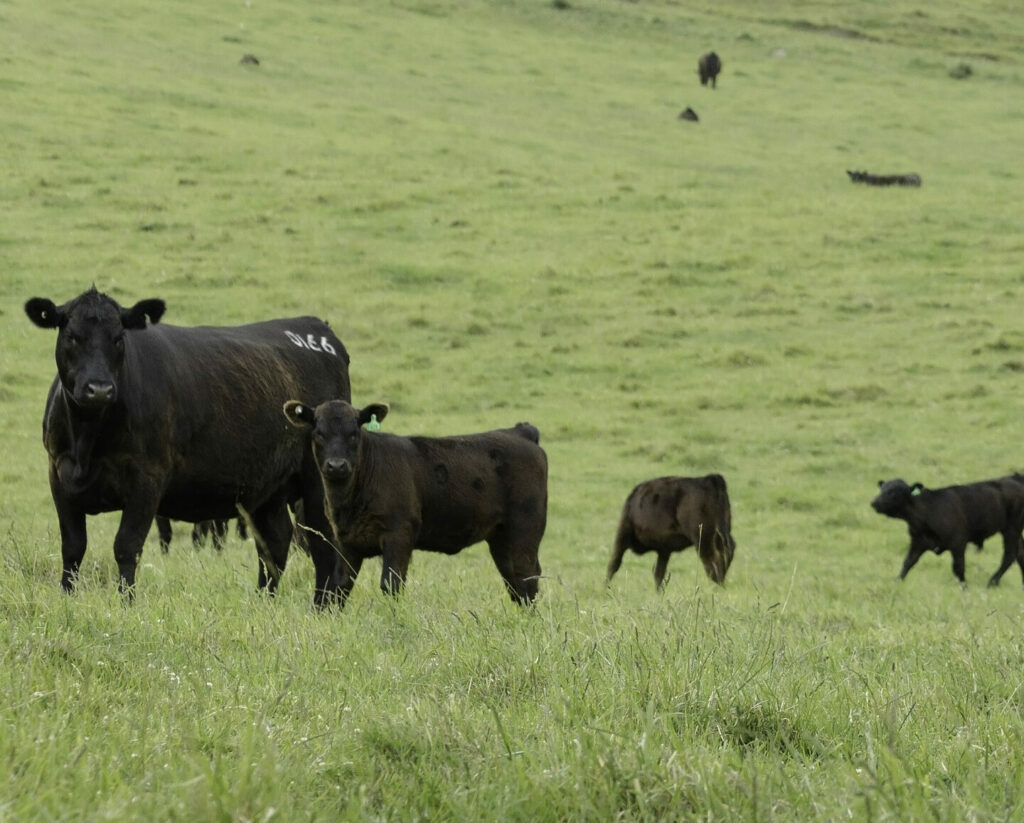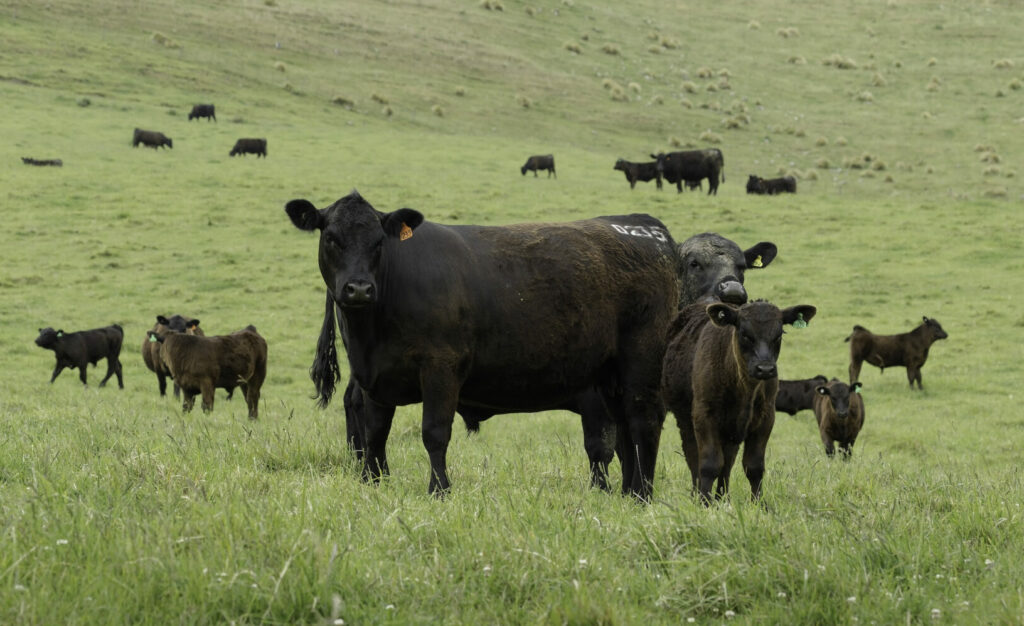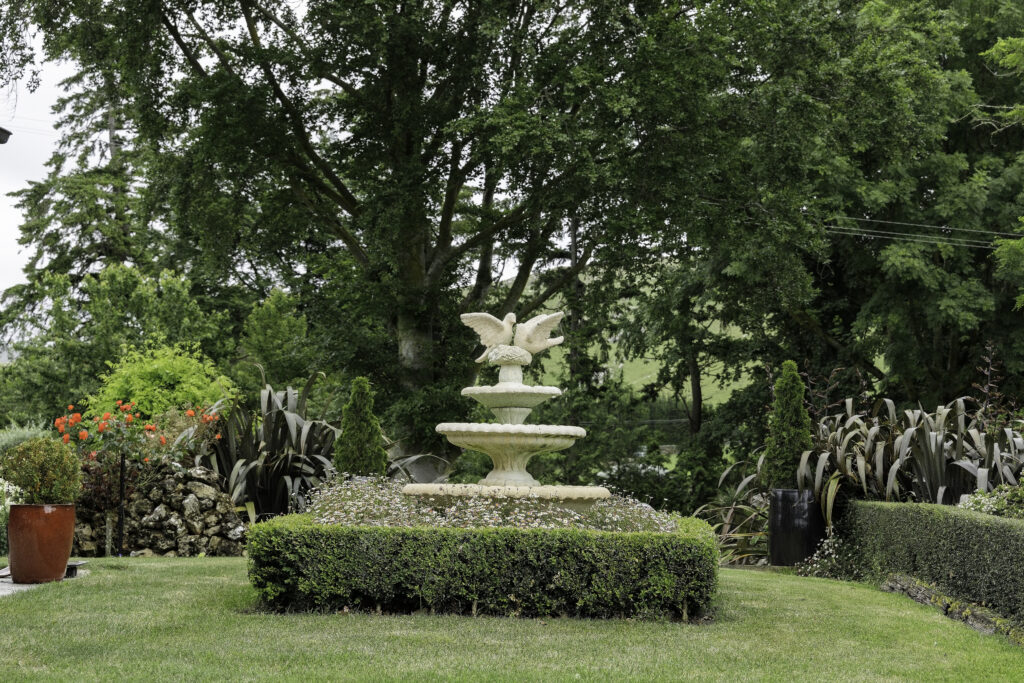
RED OAK
ANGUS
FOR BETTER BALANCED BEEF
Breeder Profile:
Rick & Deb Orr
Words by
Tim Fulton
Orr family backs pure New Zealand beef

In 100 years of breeding stud sheep, cattle and horses, Rick Orr’s family have consistently adapted to “commercial reality”.
Rick and Debra Orr started Red Oak Romney in 1990 on a steep hill country property north of Whanganui and a decade later bought a 2100ha sheep and beef farm in North Canterbury, at Weka Pass, north-west of Amberley.
The southern operation was a continuation of family involvement in stud breeding that started with Rick’s grandfather, Leonard Louie (Dick), who got into pedigree Jerseys after World War One. Dick also had a passion for thoroughbred horses which he bred and raced successfully till the mid-1960s.
Rick’s father, Ross, continued the Jersey stud and it was one of the top producing herds in the Waikato when it was dispersed in the early ’70s.
After a decade or so of involvement in other business, the Orrs started a Simmental cattle stud in the early ’80s and through the ’90s under the management of Rick’s brother, Jon.
Meantime, through the ’80s Rick had graduated from Lincoln and worked on hill country properties in both the North and South Islands. In 1989, the family bought a steep hill country farm in the Mangamahu Valley, north of Whanganui. The Red Oak Romney stud was founded soon after, initially to supply rams
for the farm’s own 6500 Romney ewes. As performance results took off, so did ram sales around the central North Island.
The Mangamahu property had a beef cow herd of around 500 cows plus 100 heifers to the bull – a platform for the Red Oak Angus Stud founded in 2000.
Rick says at the time he felt some of the imported genetics were not suited to steep Whanganui hill country conditions.
“We purchased foundation cows with as much old New Zealand bloodlines as possible. As a stud breeder I did not take over my father’s long-established Romney or Angus stud. We started from scratch with definite commercial-based objectives of producing as much meat and wool per hectare at the lowest possible cost.”


In 2001, the Orr family sold its two North Island properties to enable Rick and his two brothers to disperse and do their own thing. Debra and Rick retained the best 9000 stock units from Mangamahu, including both studs, which were sent to Weka Pass.
On country with commanding views toward Christchurch and parts of the Hurunui, Red Oak now runs 15000 stock units on rolling downs to steep tussock ranging from 200- 860m. Rick says a good deal of the place is strong limestone country.
When Red Oak Angus stud started 22 years ago, Rick decided not to follow the many Kiwi breeders who were importing American and Australian genetics in a big way.
“When all the breeders started getting into American genetics we were on steep Whanganui – Mangamahu – hill country and the Angus had been around and performed in New Zealand’s environment for 100 years.
“Then they started bringing in these animals that were used to feed lots; you know, it’s pretty easy to get performance when you’re just waiting for the silage trailer to come every day in a feed lot,” he says.
Red Oak aims to breed sound moderate frame size cattle with barrel and constitution focusing on maternal traits of reproduction, milking ability, quiet temperament, and longevity. Heifers are mated as yearlings, calving as two-year olds and these are still performing well in the herd at 14- or 15-year- olds.
Rick originally sourced Angus cows from Waimata and Waiwera in Gisborne and a few cows from Shian Angus in Taumarunui. He was looking to breed a base herd of “pure New Zealand” Angus that could handle tough conditions, perform well and tidy up poor quality pasture for the sheep.
The sires “have been bred and performed under New Zealand hill country conditions” and until recently, no imported semen has been used. The imported genetics in the herd are only there to allow benchmarking with the small number of pure Angus New Zealand bloodlines, Rick says.

Probably only six breeders in the country could now claim to have pure New Zealand bloodlines, he says.
“And the problem is you’ve got a confined lot so you haven’t got any links, which is what you need to get your figures up.
“Of our 300 stud cows, around 80 would be pure New Zealand and the rest would be close to it. We do use some overseas genetics but only after we are satisfied they have proved themselves under New Zealand conditions. We’ve got a dry, hill country. That’s got a lot of challenges and the cattle have got to suit the environment.”
Rick is determined to keep a pure New Zealand base as much as possible, seeing the value for the wider industry with successful cross-breeding, like the Angus-Hereford cross, for example. And of course, there’s the bigger consideration that there’s no going back once that pure New Zealand base is lost.
The 300 Red Oak stud cows at Weka Pass used to run alongside around 400 commercial cows and those cows are still instrumental in maintaining pasture quality during favourable conditions in spring or autumn, when there can be an explosion of pasture growth. The cows rearing their calves through the dry summer months are usually tasked with controlling dead, poorer-type grasses till the cows are two-year-olds.

After successive droughts the 400 commercial cows had to be sold. Now, with the purchase of Palmdale at nearby Omihi, Red Oak has bought 600 of its own steers off clients, so the model has changed.
Red Oak starts calving round the start of August and runs through to the end of September. The cows are expected to clean up rank grass, get in calf again and wean a top calf, usually in mid March.
As Rick now watches a son and daughter carry on farming on the home block and the new property, Palmdale up at road at Omihi, he’s able reflect on how breeding technology continues to improve sheep and beef.
Back in 1994, Rick was the first in the country to scan rams for Eye Muscle Area (EMA) and in the last few years he’s done some genomic testing.
“Now, just watching some of the bulls, their EBVs have changed just based on the genomic results. And that’s proven right in a lot of cases,” he says.
As for EBVs, whereas Rick used to think the industry was over-playing the importance of genetic background and not enough on actual performance, he says the value of the performance recording is starting to show. He advocates “a balanced approach using Estimated Breeding Values as a
guide depending on accuracies combined with actual figures and common-sense stockmanship”.


Recorded traits like growth, scrotal size, temperament, milking ability, carcase conformation and structural soundness should be plainly obvious to discerning cattlemen and cattle breeding is mainly about generational improvement, he says.
“You get 50 per cent from your mother and 50 per cent from your father, and if you keep putting high figures over high figures, actually you’re breeding a piece of paper. Look, EBVs work fine, but only when you’ve got a heap of progeny. If you’ve 200 progeny then your EBVs start to come right.”
Breeders would once commonly buy a bull that was estimated to have good figures but find a couple of years later that the progeny hadn’t performed as well as expected.
“Their figures could change – could go up or down. A lot of people would get frustrated – they’d buy a bull and then two years later the figures are rubbish. So, if genomics can help make it more relative and more accurate then that’s got to be a benefit.”
Over the past three years Red Oak has averaged just on 100 per cent calving in both studs and commercial cows (cows scanned in-calf to calf marking). Generally the stud gets about 3-4 per cent of cows having twins and its dry rate at scanning is between 3-8 per cent, depending on the seasons.
100-YEAR STUD STOCK HERITAGE CARRIED BY FOUR GENERATIONS Rick Orr’s grandfather, Leonard Louie (Dick ) Orr was a veteran of both world wars and remembered by Rick as a “tough as teak hero”. An undefeated light heavyweight armed forces boxing champion, Dick applied the same determination to breeding Red Oak Jerseys and a few thoroughbreds for 30 years, when a farming injury meant he had to drag his only son Ross Orr out of boarding at King’s College in Auckland to come home and run the farm. Ross turned the RO Jersey stud into one of the top producing herds in the Waikato, holding cow and bull sales selling up to 60 stud yearling bulls annually. He won the New Zealand Young Farmer in 1961. In those days the prizes were trips to the UK where Ross learnt from the best in Britain and made lifetime friends and contacts which he still has now at 85 years old. After selling the Jerseys in the early 1970s, the Orr family dabbled in a few small Simmental studs through to the purchase of Mangamahu in Whanganui in 1989. Rick and Debra were married in 1989 and she has been a major part of the operation. Debra’s Red Oak Garden is testament to the commitment and attention to detail she has given to the family business, Rick says. Now a fourth generation of Orrs are involved with the farming operation – son Ash with Tamara at newly purchased Palmdale are running the Romney and Half-bred flocks, while daughter Vanessa is with Mike at Red Oak. Rick takes real pleasure in seeing them interested in farming and the stud operations. “Both have children now so the possibility of a fifth generation carrying the Red Oak name on is very real,” he says.

